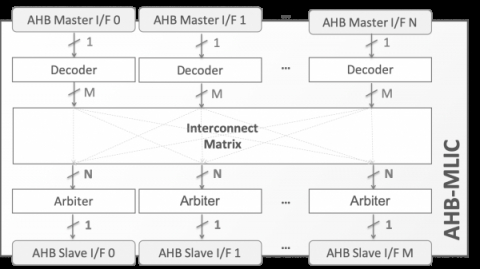AHB Multilayer Interconnect
The multilayer fabric offers higher interconnect throughput than a typical AHB bus, as arbitration is performed at the slave port and therefore masters do not compete for bus control. In practice, each master accesses the peripherals connected to the slave ports via a dedicated bus, and only competes with others when they attempt to access the same peripheral at the same time.
The highly-configurable AHB-MLIC allows users not only to define the number of master ports and the number of slave ports, but also to define the slaves’ addresses per master port and the arbitration scheme per slave port. Also, it is possible to enable or disable slave access per master. To ease the core configuration, the deliverables include a software application that enables users to configure the fabric via an intuitive HTML interface and automatically generate the corresponding Verilog parameter values.
The LINT-clean and scan-ready AHB-MLIC core is extensively verified and proven in multiple production designs. It can be mapped to any ASIC or FPGA, provided sufficient silicon resources are available, and it is delivered with everything required for successful implementation including a test-bench and comprehensive documentation.
View AHB Multilayer Interconnect full description to...
- see the entire AHB Multilayer Interconnect datasheet
- get in contact with AHB Multilayer Interconnect Supplier
Block Diagram of the AHB Multilayer Interconnect IP Core

AHB IP
- SD 4.1 / SDIO 4.0 / eMMC 5.1 Host Controller
- AHB Octal SPI Controller with Execute in Place
- FlexNoC 5 Network-on-Chip (NoC)
- FlexNoC Functional Safety (FuSa) Option helps meet up to ISO 26262 ASIL B and D requirements against random hardware faults.
- CodaCache® Last Level Cache IP
- SD 3.0 / SDIO 3.0 / eMMC 5.0 Host Controller








